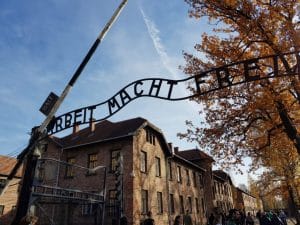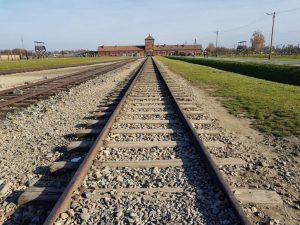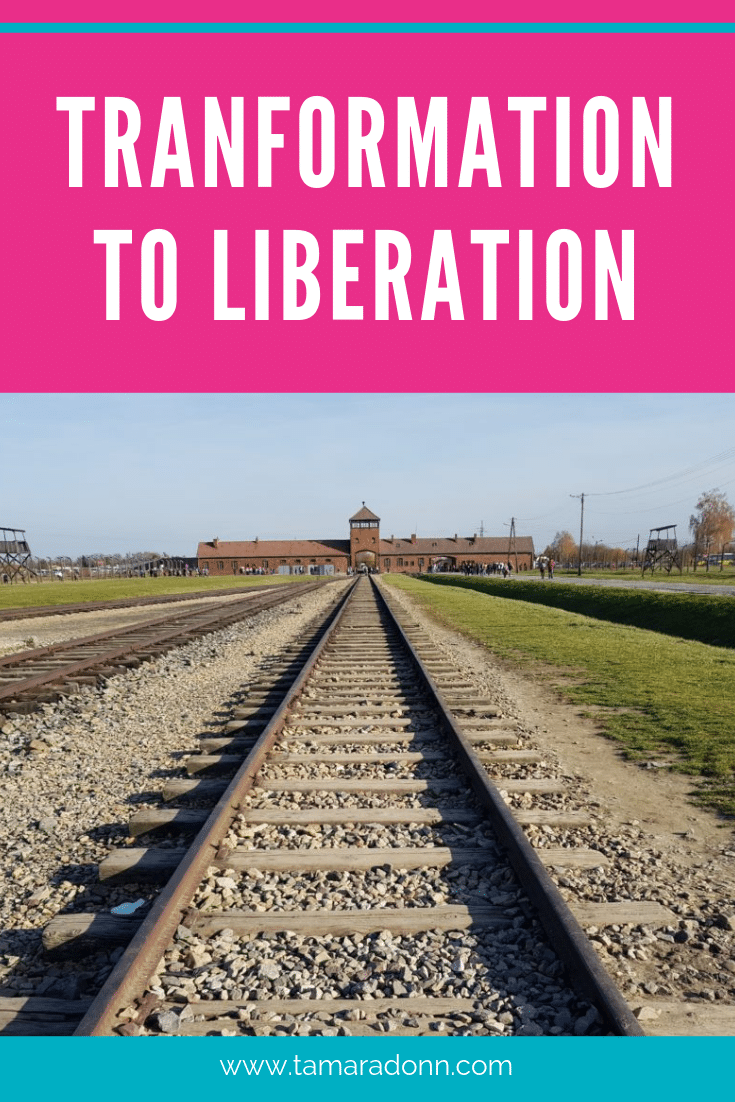Warning – contains upsetting material
My great grandparents were deported to Auschwitz in 1943. My great grandfather arrived on 3rd Mar 1943 and his wife a day later. Men were rounded up separately from women. They probably never met again once they had been separated. From this point on their fate is unknown.
From my trip to Auschwitz, I learned that they most probably arrived after a long and painful train ride standing up in a cattle truck filled with hundreds of squashed people and a single toilet bucket. On arrival they would have stood on the infamous platform where a doctor would dictate their future by looking at their age and fitness. Thumb left – gassed to death immediately. Thumb right – worked to death or until it would be their turn to be gassed.

Due to the fact that they were in their 60s they would have probably been spared the horrific, terrifying and degrading conditions of the slow work to death scenario. On the tour we were told that to keep the victims calm, they were informed that they should label their suitcases with their names and dates of birth so that they could be reunited with them later. The gas chambers were disguised as shower blocks surrounded with neatly tended flower beds and realistic changing room with numbered hooks for their clothes to be identified later. To prevent other prisoners finding out about their final destination, the gas chambers were located underground so that their 20 minutes of screaming (the time it took for the most resilient humans to suffocate from exposure to the gas Zyclone B) stopped.
I asked our tour guide if anyone survived the gas chambers. The Sonderkommando (fellow prisoners who were forced – on threat of their own deaths – to lead the victims into the showers and later collecting the dead bodies, removing long hair from women to recycle and moving them rapidly into the crematorium) did witness this. One 14 year old girl was found alive under a heap of dead bodies, probably due to an air bubble. She could not remember what had happened but was shot anyway to make sure she couldn’t tell anyone about the gassing. Another baby had survived by suckling her dying mother’s milk but was also killed anyway.
Any remaining bones and teeth or other evidence of human remains within the ashes of the dead bodies were smashed before being loaded into lorries and emptied into a local river to remove evidence.
Interestingly, the most challenging part of this trip were the practical ones. Getting stuck in the lift at the start of the day when the tour bus was due to pick us up from our accommodation didn’t help. Being told on the bus that we were not allowed to bring in bags larger than 30 x 20 x 10 cm when mine was larger so having to select which essential items I wanted to have with me and stuff in my pockets (reminiscent of leaving ones belongings behind before travelling to the concentration camp), wearing an orange sticker to identify which tour group I was in (reminiscent of wearing an identifiable symbol such as a yellow star for jews and a black triangle for gypsies) and being rushed from one place to another without having time to absorb these horrors.
My grandmother escaped these horrors and for her I am thankful I exist. She never spoke of her past so I can only piece together from history and the remaining documents we have.
I only realised fully what an impact my past has on me, when I attended a conference for 2nd and 3rd generations of holocaust survivors. Meeting other people with similar histories was fascinating. A common theme was not feeling safe, which I can relate to.
My trip to Auschwitz was part of a personal journey I am on which I have named Transformation into Liberation. From what we learn from resent research in epigenetics, trauma continues into future generations. Rachel Yehuda, Professor of Psychiatry and Neuroscience, specialises in understanding the effects of stress and trauma beyond cataclysmic events, to the next generation and possibly beyond. Her research suggests that descendants of holocaust survivors have altered stress hormones that may hamper their ability to bounce back from trauma. Family constellations, a system of healing the individual through exploring the family system, also accepts the correlation for trauma in previous generations affecting descendants. My fascination for my family history, has led me to experience deep healing through this system.
Unlike most people (I imagine) we did a lot of internal preparation for this trip. We watched films and documentaries about the holocaust and Auschwitz, tapping on anything and everything that came up for us. I have avoided watching films of this nature in the past as I have found them deeply destabilising. This time we tapped before watching the films as well as pausing the films when difficult emotions arose.
One of the most challenging scenes for me was the wheelchair scene in the film The Pianist, where the Nazis throw a man in a wheelchair out of a third floor balcony in his home in front of his family. I have tapped so far for 3.5 hours on this scene and have uncovered so many aspects which keyed into my own family story. But have still not reached the end of it.
Some of the aspects I tapped on and released are (connected to this scene, other films and what I imagine happening to my own family):
- Desperation
- Parents and children being ripped apart from each other
- Children alone and terrified
- Children gassed
- Humiliation
- I’ll never get over this
- If this is the world I live in, I don’t want to be part of it
I also prepared for the trip with homeopathy and my homeopath gave me some remedies to leave in Auschwitz to help heal the land and energy of the place. I left some on the life and death selection platform, the wooden bunk beds in the barracks where 5-6 inmates would share one bunk and at the memorial at the site of the gas chambers ruins destroyed by the Nazis to remove evidence when they realised they were losing. I also buried a rose quartz crystal in the train tracks on the selection platform.

I wrote up to here at 5:30am the morning after visiting Auschwitz. Since then I have learnt that the Auschwitz death camp is just the tip of the iceberg and that it was just one of many death camps in Poland and the rest of Europe. The reason we mainly hear about Auschwitz is that there are so many survivors. Another death camp which was completely destroyed called Belzec where about 500,000 people were killed. There are only 7 known survivors.
Visiting Auschwitz and Krakow was part of my desire to find a way to agree to the events of my past, keep the memories of those lost in my heart, so that I can step into my life fully with freedom and liberation. I have now come to realise that it is and always will be incomprehensible and I am learning to come to terms with that. I have also concluded that it is also fully OK for me to live a full life filled with joy and fulfilment and my sense is that this is what my great-grandparents would want for me.

